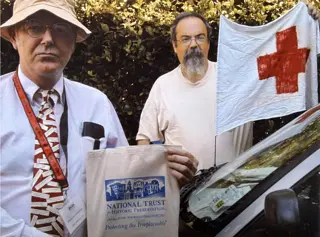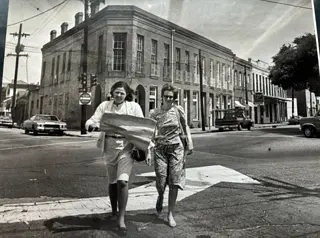An Exceptional Contribution to Preservation: Camille and Duncan Strachan
Camille and Duncan Strachan are the 2024 recipients of the President’s Award for National Leadership in Historic Preservation. The award, which recognizes an individual or organization that has demonstrated exceptional contributions to the field of preservation, is selected at the discretion of the President of the National Trust for Historic Preservation.
2024 President’s Award for National Leadership in Historic Preservation: Camille & Duncan Strachan
Over fifty years ago, the Lower Garden District was far from the thriving neighborhood as we know it today. Historic buildings sat in disrepair, houses weathered by neglect, and a looming project to construct a new bridge ramp threatened to cut through the area’s historic fabric. Camille and Duncan Strachan, partners in life and preservation, saw what was at stake and took action.
As co-founders of the Coliseum Square Association, the Strachans secured the area’s listing on the National Register, blocked destructive highway plans, and championed the restoration of treasured green spaces. Camille’s preservation influence would extend beyond New Orleans as the founding member of the National Trust Community Investment Corporation (NTCIC), which has fueled billions of dollars in historic rehabilitation projects nationwide.
The following Q&A is with Camille Strachan, an attorney and lifelong preservationist. Learn more about the full slate of 2024 awardees here.

photo by: Strachan Family
Lower Garden District residents protesting a proposed bridge that would have destroyed the neighborhood. Camille and Duncan are standing in the middle.
How did you and Duncan mobilize others to join your cause in revitalizing the Lower Garden District?
At first, we had no great vision of revitalization. We were enjoying the neighborhood and fortunate to be joined by restoration architects, urban planners, real estate brokers, a PR professional, and doctors—all of whom brought documented skills far beyond ours and happily pitched in to introduce others and host events. It wasn’t until the “bridge scare” came along that we felt it was necessary to have an organization.
In 1972, the State Transportation Department had proposed a second Mississippi River bridge at Napoleon Avenue, which ran through the bosom of uptown. The new route was Felicity Street, down the middle of the Lower Garden District. We knew what the first bridge had done to the area; the neighborhood had become significantly disinvested by the time we came along. We formed the Coliseum Square Association as a nonprofit organization so that we could accept donations to help us fight the proposed bridge.

photo by: Strachan Family
Duncan Strachan and Ellis Joubert following Hurricane Katrina.
One of the first things we did was apply to have the neighborhood listed on the National Register of Historic Places. William Murtaugh, the Keeper at the time, came to New Orleans and I had the opportunity to be his guide. Driving him around, he seemed discouraged that there was any hope for the application to be approved. We invited him to the house for a drink, and a while later, the application was approved.
The neighborhood called that drink the “Bourbon Renewal.”
You’ve been known for your creative and sometimes daring approach to preservation.
As part of the process, Governor Edwin Edwards convened a public meeting of the State Transportation Department at the Roosevelt Hotel. Duncan happened to have a half-track, so the neighborhood got in it and drove downtown. As we were pulling up, we thought that arrests were imminent, but the governor was amused and invited us in.
After a lot of other struggles, we struck a deal with the transportation department to take down the intrusive ramp out of the Lower Garden District and not build an access on Felicity Street.
Stay connected with us via email. Sign up today.
The work you and Louise Martin did with Felicity Street Redevelopment to revive Central City is remarkable. How did you convince others to invest in an area that many had written off?
Together with our husbands, Louise and I had done four buildings on the commercial corridor of the Lower Garden District on Magazine Street, and we were always interested in Lower St. Charles Avenue, which had become disinvested over the years. There was an announcement that some of the housing there was going to be bulldozed for a big box store.
We used Felicity Street Redevelopment as a mechanism to introduce people into the neighborhood. We established a revolving fund and started out with the acquisition of eleven rental properties that a private investor was anxious to get out from under. We restored the exteriors, the foundations and the roofs, and returned the interiors to their original footprint. The National Trust was a big help with the Inner Cities Ventures Fund, which extended a line of credit to Felicity Street that we spent and repaid three times.
The big box store was not built, but affordable housing was, and Felicity Street ended up moving one of the surviving structures to make way for it.

photo by: Strachan Family
Camille Strachan and Louise Martin at the 3-way corner of Magazine Street, St. Andrew Street, and Sophie Wright Place in New Orleans.
What vision did you have for NTCIC when it was established, and how do you feel that vision has come to fruition?
As the National Trust phased off federal funding, NTCIC was formed in 2002 as a for-profit subsidiary to offset the parent’s loss of $9 million dollars a year. It became a leader in the syndication of federal and state historic, new markets, and solar credits. NTCIC has financed over $2 billion in tax credit equity in over 200 projects across the U.S. which has supported $10 billion in development costs.
The late Tony Goldman who served on the boards of the National Trust and NTCIC had a great line: “Doing well by doing good.” Putting neighbors back in neighborhoods, and recognizing that places matter, are tenets that NTCIC carries on.
You’ve spent decades preserving neighborhoods—but preservation is also about the people in them. Can you share a moment when your personal values guided your approach to community and place?
I hope that we were the same people as when we started out. Duncan and I agreed that generosity of spirit is a most important human characteristic and knows no skin color. We tried to approach whatever we did in the same way, particularly as evidenced by Hurricane Katrina. We rode out the storm and Duncan, wearing a tie and a National Trust name badge, went all over New Orleans to check on friends’ houses and photograph the extent of the disaster citywide. The National Trust showed generosity of spirit by creating a group of volunteers that recruited nationwide to work with the Preservation Resource Center in the Lower Ninth Ward.
Donate Today to Help Save the Places Where Our History Happened.
Donate to the National Trust for Historic Preservation today and you'll help preserve places that tell our stories, reflect our culture, and shape our shared American experience.


.webp)
